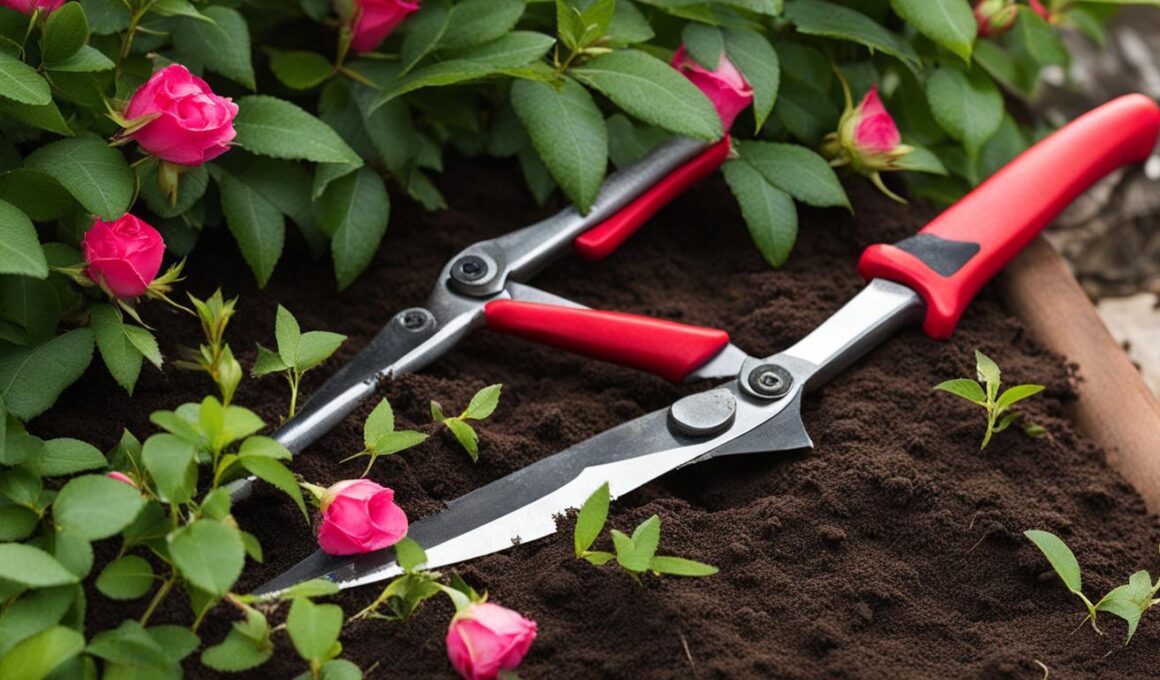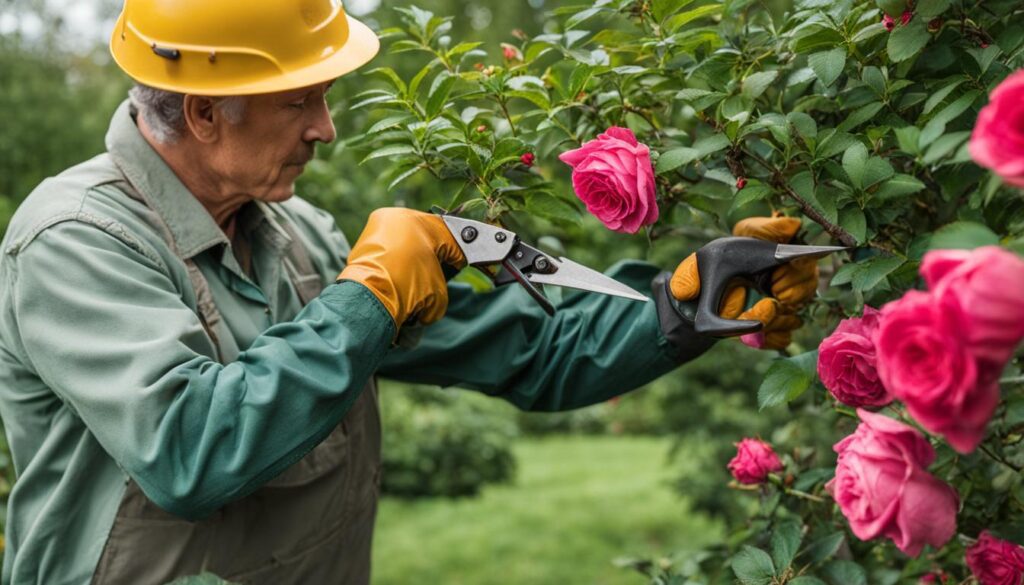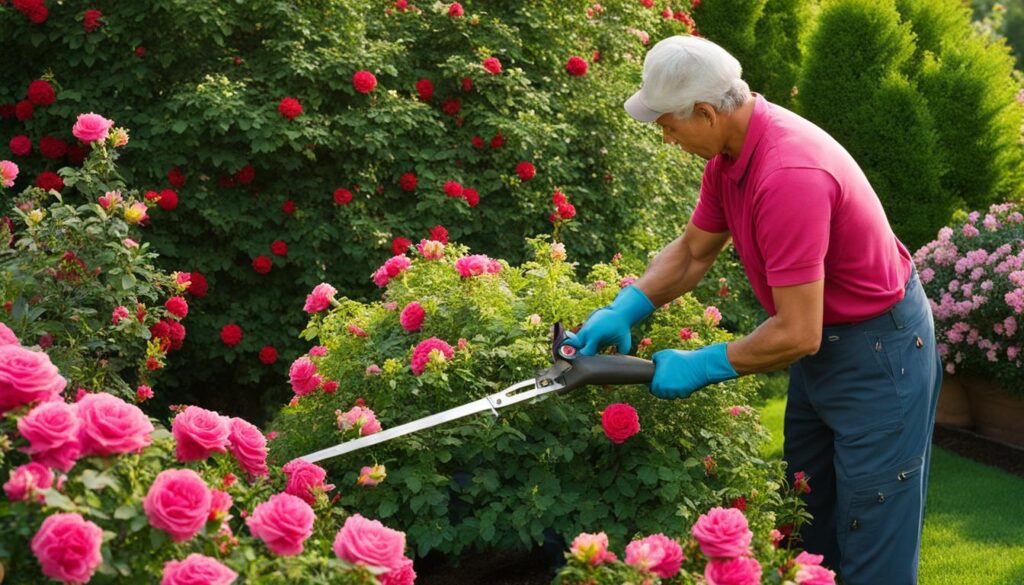Drift roses are a popular choice among gardeners for their vibrant blooms and low-maintenance nature. Knowing when to cut back drift roses is essential for keeping them healthy and promoting new growth. In this article, we will provide expert advice on the best times to prune your drift roses, ensuring that your garden remains vibrant and beautiful throughout the year. This advice is based on the expertise of rosarian Paul Zimmerman, who emphasizes sustainable and organic rose care.
Key Takeaways:
- Pruning drift roses is crucial for their health and vitality.
- The best time to prune most roses, including drift roses, is at the end of the dormant season.
- Understanding the specific blooming patterns of your roses will guide you in determining the best time for pruning.
- Tailor your pruning technique based on the type of rose you have.
- In addition to pruning, proper plant selection, good genetics, and essential care are crucial for the overall health and growth of drift roses.
Understanding the Nature of Roses: Advice from Paul Zimmerman
Paul Zimmerman, a consulting rosarian and author of the book “Everyday Roses: How to Grow Knock Out and Other Easy-Care Garden Roses,” believes that roses can be successfully grown without the use of harsh chemicals and pesticides. He explains that viewing roses as plants, rather than mythical divas, reduces the intimidation factor associated with their care. Many gardeners shy away from growing roses due to misconceptions about their fussiness, but Paul encourages gardeners to tap into their inner rose grower and unleash their potential. By treating roses as flowering shrubs and understanding their basic needs, gardeners can achieve success with these beautiful plants.
“Roses can be grown successfully by anyone,” Zimmerman states. “The key is to provide them with the right care and attention, which includes understanding their natural growth habits, soil requirements, and pruning techniques.”
Paul Zimmerman emphasizes the importance of growing roses sustainably, without relying on harsh chemicals and pesticides. He believes that using organic methods not only benefits the environment but also promotes the long-term health and vitality of the roses. By implementing sustainable rose care practices, gardeners can create a harmonious and thriving ecosystem in their gardens.
Unleashing Your Inner Rose Grower
To successfully grow roses, Zimmerman advises gardeners to let go of the notion that roses are delicate and temperamental. Instead, he urges them to embrace their inner rose grower and approach rose care with confidence. Understanding the basic needs of roses, such as providing them with adequate sunlight, well-drained soil, and regular watering, is key to their success. Zimmerman encourages gardeners to educate themselves about the specific requirements of each rose variety they choose to cultivate so they can provide tailored care.
Growing Roses Organically
Paul Zimmerman promotes the use of organic methods in rose care, as they benefit both the plants and the environment. By avoiding synthetic pesticides and fertilizers, gardeners can create a sustainable and eco-friendly garden. Zimmerman recommends using natural alternatives, such as compost, organic fertilizers, and beneficial insects, to promote healthy growth and combat pests and diseases. By embracing organic rose care, gardeners can enjoy the beauty of their rose gardens while also supporting biodiversity and protecting the planet.
Factors to Consider: Choosing the Right Time to Prune
Pruning is a crucial aspect of caring for drift roses, as it promotes their health and growth. But when is the right time to prune? Timing is essential, and it’s important to consider a few factors before picking up those pruning shears.
According to the Southern Living Garden Book, the optimal time to prune most roses, including drift roses, is at the end of the dormant season when growth buds begin to swell. This typically happens between mid-January in warmer climates and early April in cooler climates. Pruning too early, before the final frost, can result in damage to the new growth. However, if you missed the dormancy window, don’t worry! You can still prune drift roses after they bloom in spring or summer.
Understanding the blooming patterns of your drift roses will help you determine the best time for pruning. Once-bloomers, such as ‘Lady Banks’ and ‘American Beauty,’ should be pruned immediately after they finish blooming. On the other hand, repeat-bloomers like ‘Knock Out’ and hybrid teas can be pruned multiple times throughout the year, in between flushes of blooms. Climbing roses require a different approach – it’s best to leave them untouched for the first two to three years after planting, with pruning limited to removing dead, crossing, or non-blooming branches.
Factors to consider when choosing the right time to prune:
- Blooming pattern: Once-bloomers vs. repeat-bloomers
- Climate: Dormant season timing varies based on climate
- Specific rose variety: Different roses have different pruning requirements
By understanding these factors and taking them into account, you can ensure that you prune your drift roses at the optimal time, promoting healthy growth and vibrant blooms.
Pruning Techniques: Tips for Cutting Back Drift Roses
Proper pruning techniques are essential for maintaining healthy and beautiful drift roses in your garden. By following these expert tips, you can ensure that your roses thrive and continue to bloom throughout the season.
1. Assess the Type of Rose
Before you begin pruning, it’s important to understand the type of drift rose you have. Once-bloomers should be pruned immediately after they finish blooming, while repeat-bloomers can be pruned several times throughout the year between flushes of blooms. Climbing roses, on the other hand, require a different approach and should be left untouched for the first two to three years after planting, with pruning limited to removing dead, crossing, and non-blooming branches.
2. Use Sharp Pruners
Invest in a pair of sharp pruners to make clean and precise cuts. This helps minimize damage to the plant and reduces the risk of disease. When pruning, make cuts at a 45-degree angle to prevent water accumulation, which can lead to rot. It’s also important to remove any dead or diseased canes at any time to maintain the overall health of the rose bush.
3. Strategic Pruning
When cutting back drift roses, strategically remove wood that is dead or lacks healthy growth. Removing foliage can help prevent disease, as it improves air circulation within the plant. Additionally, cutting back the previous season’s growth by one-third to one-half will promote new growth and ensure a more compact and aesthetically pleasing shape for your roses.
Remember to take your time and observe the specific needs of your drift roses. Each rose variety may require slightly different pruning techniques, so it’s important to tailor your approach accordingly. With patience and care, your drift roses will reward you with stunning blooms year after year.
Essential Care: Growing Healthy Drift Roses
When it comes to growing healthy drift roses, proper care is key. By following a few essential tips, you can ensure that your roses thrive and provide a stunning display of blooms year after year.
Choose the Right Roses
Start by selecting drift roses that are suited to your climate and growing conditions. Look for varieties that have good genetics and disease resistance, as this will greatly contribute to their overall health. When choosing roses, consider factors such as sunlight requirements and soil type to ensure optimal growth.
Provide the Right Conditions
Drift roses thrive in full sun, so be sure to plant them in a location that receives at least six hours of direct sunlight each day. The soil should be well-drained and rich in organic matter to promote healthy root development. Adequate air circulation is also important to prevent disease, so be sure to space your roses properly, following the planting instructions for each variety.
Implement Regular Care Practices
To keep your drift roses healthy, it’s important to provide regular care. Mulching around the base of the plants with organic materials, such as pine straw or bark, will help retain moisture and suppress weed growth. Fertilize your roses with a controlled-release fertilizer according to the package instructions to provide them with the necessary nutrients. Additionally, water your roses regularly, especially during periods of drought, to prevent stress and promote healthy growth.
By following these essential care tips, you can ensure that your drift roses remain healthy and vibrant. With proper plant selection, providing the right growing conditions, and implementing regular care practices, your rose garden will flourish and provide a beautiful focal point in your landscape.
Conclusion
Cutting back drift roses at the right time is crucial for maintaining a vibrant and thriving rose garden. By following the expert advice of rosarian Paul Zimmerman and understanding the nature of roses, you can confidently care for these beautiful plants.
To ensure the health and vitality of your drift roses, choose the right time to prune based on their specific blooming patterns and climate requirements. Implement proper pruning techniques, taking into account whether your roses are once-bloomers or repeat-bloomers. Removing dead or diseased canes at any time is also important for their overall health.
Additionally, provide essential care to your drift roses by selecting varieties suited to your climate and growing conditions. Ensure they receive full sun and well-drained soil rich in organic matter. Proper air circulation and spacing between plants will help prevent disease, while mulching and regular watering will support growth and flowering.
By following these concluding tips, you can enjoy the beauty of drift roses in your garden year after year, maintaining a vibrant rose garden that brings joy and color to your outdoor space.
– Is There a Specific Time of Year When I Should Cut Back Drift Roses for Optimal Growth?
When it comes to maintaining your drift roses, it’s important to follow a complete pruning guide for drift roses. The best time to cut back drift roses for optimal growth is in the early spring, just before new growth begins. This will help promote healthy growth and beautiful blooms throughout the growing season.
FAQ
When is the best time to prune drift roses?
The best time to prune drift roses is at the end of the dormant season when growth buds begin to swell, usually between mid-January and early April. Avoid pruning too early before the final frost to prevent damage to new growth.
Can I still prune drift roses if I missed the dormant season?
Yes, if you missed the dormant season, you can still prune drift roses after they bloom in spring or summer. Understanding your rose’s specific blooming patterns will guide you in determining the best time to prune.
How should I prune different types of drift roses?
Once-bloomers, such as ‘Lady Banks’, ‘American Beauty’, and ‘Veilchenblau’, should be pruned immediately after they finish blooming. Repeat-bloomers, such as ‘Knock Out’, floribundas, hybrid teas, and Drifts, can be pruned several times throughout the year between flushes of blooms. Climbing roses should be left untouched for the first two to three years after planting, with pruning limited to removing dead, crossing, and non-blooming branches.
How do I properly prune drift roses?
Use sharp pruners and remove dead or unhealthy wood, making cuts at a 45-degree angle to prevent water accumulation. Remove foliage to prevent disease, and cutting back the previous season’s growth by one-third to one-half will promote new growth for the next season.
What factors should I consider for the overall health of drift roses?
Proper plant selection, choosing roses suited to your climate and growing conditions, is crucial. Good genetics and disease resistance should also be considered when selecting rose varieties. Drift roses thrive in full sun with well-drained soil rich in organic matter. Adequate air circulation and spacing between plants are essential for preventing disease. Mulching with organic materials helps retain moisture and suppress weeds. Regular watering and fertilizing with a controlled-release fertilizer will further support growth and flowering.
How can I maintain a vibrant and beautiful rose garden?
By following the advice of rosarian Paul Zimmerman and understanding the nature of roses, you can confidently care for drift roses. Choose the right time to prune, implement proper pruning techniques, and provide essential care tailored to your specific drift roses. With the right knowledge and care, you can enjoy the beauty of drift roses in your garden year after year.











